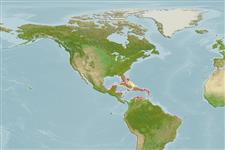Common names from other countries
Environment: milieu / climate zone / depth range / distribution range
Ecologia
; intervalo de profundidade 0 - 2 m (Ref. 2022). Tropical
Western Central Atlantic: USA, Colombia and the West Indies.
Length at first maturity / Tamanho / Peso / Idade
Maturity: Lm ? range ? - ? cm Max length : 3.8 cm TL macho/indeterminado; (Ref. 281)
Maximum Total Length: 3.8 centimeters. Body: Elongated; has girdle that covers most of the valves. Valves: Have four clumps of long, glassy bristles near the anterior valve and one on each side of the other valves. Clumps: Set in cuplike collars of the girdle. Pustules: Tiny, round, sharply raised; covering end valves and lateral areas of middle valves. Dorsal longitudinal ridge: Raised, narrow, distinct and smoothish except for very fine pinpoints. Lower edge of the girdle: Dense fringe of brown or bluish bristles (Ref. 281).
Upper sublittoral, under stones and coral rubble (Ref. 2022, page 123).
Life cycle and mating behavior
Maturidade | Reprodução | Desova | Ovos | Fecundidade | Larvas
Members of the class Polyplacophora are mostly gonochoric. Life cycle: Eggs hatch into lecitotrophic planktonic trocophore larvae (no veliger stage) which later metamorphose and settle on the bottom as young adults.
Burghardt, G. and L. Burghardt. 2006. (Ref. 281)
Status na Lista Vermelha da IUCN (Ref. 130435)
Status no CITES (Ref. 108899)
Not Evaluated
Not Evaluated
Uso pelos humanos
| FishSource |
Ferramentas
Mais informação
Idade/TamanhoCrescimentoComprimento-pesoComprimento-comprimentoMorfologiaLarvasAbundância
Fontes da internet
Estimates based on models
Preferred temperature
(Ref.
115969): 23.8 - 28.3, mean 27.1 (based on 319 cells).
Vulnerabilidade
Low vulnerability (10 of 100).
Categoria de preço
Unknown.
